Diamond Reports
LABORATORY-GROWN
DIAMOND FACTS

Summary QUICK FACTS

Unpolished laboratory-grown diamonds created via Chemical Vapour Deposition (CVD) method.
Laboratory-grown diamonds are manufactured products that have the same crystal structure as natural diamonds and have nearly the same chemical, physical and optical properties when polished.
They are not identical to natural diamonds and are always distinguishable with professional equipment*.
Laboratory-grown diamonds and natural diamonds have very different creation processes.

IMAGE CREDIT: GIA • Unpolished laboratory-grown diamonds created via High Pressure High Temperature (HPHT) method.
Laboratory-grown diamonds are mass-produced in potentially unlimited quantities within days or weeks in factories located primarily in China and India. Natural diamonds are rare gemstones that formed deep within the Earth up to 3.7 billion years ago.
MANUFACTURING LABORATORY-GROWN DIAMONDS REQUIRES LARGE AMOUNTS OF ENERGY IN ORDER TO SUSTAIN FOR DAYS/WEEKS TEMPERATURES UPWARDS OF AROUND…
2,000 °F
(DEGREES FAHRENHEIT)
AND LARGE AMOUNTS OF WATER TO COOL REACTORS.
OVER
70%
ARE PRODUCED IN CHINA AND INDIA WHERE MOST GRID ELECTRICITY IS GENERATED FROM FOSSIL FUELS (COAL). ONLY A FEW LABORATORY-GROWN DIAMONDS ARE PRODUCED USING RENEWABLE ENERGY.
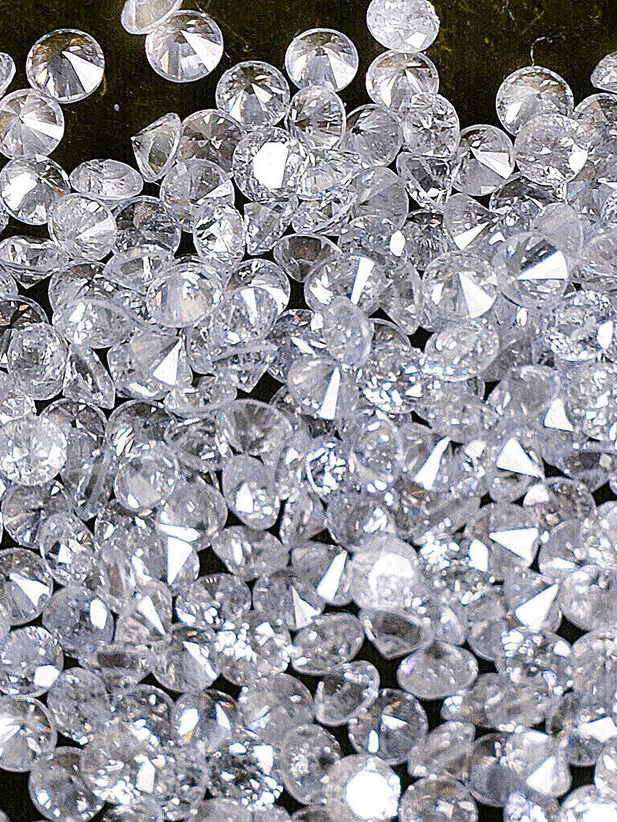
IMAGE CREDIT: EBAY
Polished laboratory-grown diamonds.
Approved
Terminology Only
Three terms can be used in the marketing of laboratory-grown diamonds:
‘laboratory-grown diamonds’
‘laboratory-created diamonds’ and
‘synthetic diamonds’.*
*Can vary according to national regulation.
PRICES OF LABORATORY-GROWN DIAMONDS ARE
down by
95%
AT WHOLESALE
Prices of laboratory-grown diamonds have dropped significantly. For example, since 2018, the average price for a 1 carat round near colourless laboratory-grown diamond with very slight inclusions* has dropped by 95% at wholesale and 76% at retail.
* VS1 clarity, FGH colour
Price
Structure
As a manufactured product the prices of laboratory-grown diamonds are dependent on manufacturing capacity rather than rarity in nature.
INTRODUCTION
Foreward

A diamond is something to behold from all angles, its brilliance lying in the way it reflects light in all directions. Sadly, claims about the diamond industry are often polarising, shedding light on single facets but failing to reflect the whole picture.
This is especially the case when laboratory-grown diamonds are discussed online. Although synthetic gems have been on the market since the 1970s, commercial manufacture has dramatically increased in the last decade, as have myths and oversimplifications about what they are and what they mean for the diamond industry. All too often, laboratory-grown diamonds are pitted against natural diamonds in meaningless comparisons that only leave consumers in the dark.
In this report, the latest in our well-received Diamond Facts series, we set out to address some of the common misconceptions surrounding laboratory-grown diamonds and share the latest data from globally respected analysts and researchers.
At the request of industry, we are here to provide an accurate source of information to which journalists, retailers, consumers and industry leaders can refer. This is intended to neither dazzle nor disparage.
By examining laboratory-grown diamonds from all angles, we aim to give consumers and other stakeholders a complete and accurate picture about the two different product categories that will inform more nuanced conversations in the public domain and help consumers make confident choices.
We hope you find the information helpful, and we welcome your suggestions of other issues or datapoints we should cover so that our Diamond Facts reports can shed light on misunderstood or complex areas.
David Kellie
CEO, Natural Diamond Council
Synthetic diamonds were first manufactured some 70 years ago, and the first synthetic jewellery-quality stones appeared on the market in the 1970s.
As their number has proliferated so too have inaccurate and misleading claims about them, which has made it difficult for consumers to make informed decisions.
In 1971, the Gemological Institute of America (GIA) examined the first jewellery-quality synthetic diamond1.
In this report, we aim to provide an accurate and balanced source of information about laboratory-grown diamonds, backed by reliable data. We’ll also delve into some of the nuances that are often overlooked or not clearly explained in coverage of this topic.
THE REPORT WILL COVER:
Definitions, explaining how laboratory-grown diamonds are made and legally defined
Disclosure, explaining grading reports and addressing the misconception that laboratory-• grown diamonds are indistinguishable from natural diamonds
Sustainability, delving into the nuances of environmental claims made by some actors of the synthetic diamond industry
Pricing, examining how production costs have changed over time and how pricing structures differ from those used for natural diamonds
Natural diamonds and laboratory-grown diamonds are two different product categories. Both have a place in the market. Directly comparing them on value, meaning or impact is not helpful to consumers and only perpetuates misinformation. Our intent with this report is to present the facts so that individuals across society can exercise their own judgment.
UNDERSTANDING LABORATORY-GROWN DIAMONDS
What are laboratory-grown diamonds?
Laboratory-grown diamonds are manufactured products that have the same crystal structure as natural diamonds and have nearly the same chemical, physical and optical properties when polished. Unlike the natural gems that formed deep within the Earth up to 3.7 billion years ago, laboratory-grown diamonds are mass-produced in a matter of weeks if not days in factories located primarily in China, India and Singapore.
Contrary to often repeated claims online, laboratory-grown diamonds are not identical to natural diamonds and are always distinguishable.
How are laboratory-grown diamonds made?
Scientists spent decades engineering synthetic alternatives to replicate the hardness, optical properties, and thermal conductivity of natural diamonds in a more scalable and affordable way, so they can be used for industrial and technological applications.
There are two main processes used to create laboratory-grown diamonds. The production method used does not affect the look or cost of the polished product.
Both methods require a tiny diamond crystal, called a ‘seed’, to serve as a base upon which the stone can be grown and a blueprint for its crystal structure. The seed can be natural but is commonly grown in a laboratory.
The size of a laboratory-grown diamond depends on the time allowed for growth.
HIGH PRESSURE, HIGH TEMPERATURE (HPHT) METHOD
Imagine if you had to balance a commercial airplane on your fingertip while standing in a violet-flame fire. That’s the level of pressure (5-6Pa) and temperature (around 3,000 degrees Fahrenheit) required to create a synthetic diamond using the high-pressure, high-temperature (HPHT) method. Large reactors mimic the conditions under which natural diamonds formed in the Earth, but in a short amount of time. This process transforms graphite into a distinctively shaped laboratory-grown diamond crystal.
CHEMICAL VAPOUR DEPOSITION (CVD) METHOD
The newer technique involves breaking down the molecules of a carbon-rich gas, such as methane, into carbon and hydrogen atoms at temperatures of around 2,000 degrees Fahrenheit. The atoms are then deposited on a seed plate to produce a square-shaped, tabular diamond crystal.

DISCLOSURE RULES FOR RETAILERS
Do all retailers have to declare laboratory-grown diamonds?
Yes! Clear diamond terminology exists to guide audiences on how to refer to laboratory-grown diamonds.
Across the world, there are now global standards and national legislative requirements which must be followed by anyone selling these products, with the aim to protect consumers from misleading marketing.
THE KEY POINTS FROM THE STANDARDS ARE:
• The word ‘diamond’ used on its own must always refer to a natural diamond.
• Just three terms can be used to describe synthetic diamonds:
‘synthetic diamonds’.
‘laboratory-grown diamonds’ and
‘laboratory-created diamonds’
• Terms that include the manufacturer’s name, followed by the word
‘created’ are also permitted in the US.
• The words real, natural, genuine and precious can only be used in conjunction with a natural diamond from the Earth – these descriptors cannot be used with a laboratory-grown diamond.
• Man-made, cultured, and above-ground are not acceptable modifiers when used alone.
CHEMICAL VAPOUR DEPOSITION (CVD) METHOD
The newer technique involves breaking down the molecules of a carbon-rich gas, such as methane, into carbon and hydrogen atoms at temperatures of around 2,000 degrees Fahrenheit. The atoms are then deposited on a seed plate to produce a square-shaped, tabular diamond crystal.
Here are some examples of key standards and legislative requirements.
INTERNATIONAL STANDARDS ORGANIZATION (ISO)
The ISO 18323:2015 standard on consumer confidence in the diamond industry provides global guidelines and clearly defines terminology to be applied, including three accepted modifiers: ‘synthetic’, ‘laboratory-grown’ and ‘laboratory-created diamonds’12
CIBJO (WORLD JEWELLERY CONFEDERATION)
Created by the World Jewellery Confederation in consensus with global trade, the Diamond Blue Book records trade practices and nomenclature for the diamond industry throughout the world13. The guidance is aligned with the ISO 18323:2015 described above and complements existing national fair-trade legislation. In the absence of relevant national laws, this guidance can be considered as the trading standard.
US REQUIREMENTS
In 2018, the US Federal Trade Commission (FTC) released guidelines for the jewellery, precious metals and pewter industries that warned against the use of terms like ‘natural, real, genuine and precious’ (which can be used for natural diamonds from the Earth), in the marketing of laboratory-grown diamonds to prevent confusion between two distinct categories14. Three modifiers were approved by the FTC for the description of laboratory-grown diamonds: ‘laboratory-grown’, ‘laboratory-created’ or ‘(manufacturer’s name) created’. ‘Synthetic’ can also be used. ‘Man-made’, ‘cultured’ and ‘above-ground’ are not acceptable modifiers for laboratory-grown diamonds. Abbreviations such as ‘lab-grown diamonds’ are not accepted. When used alone, the word ‘diamond’ always means a natural diamond.
UK REQUIREMENTS
The UK’s Advertising Standards Authority (ASA) referred to terminology guidance developed by the National Association of Jewellers (NAJ) and other leading industry organisations in a ruling stating that diamond advertising must ensure that proper disclosure is done and appropriate terminology is used for laboratory-grown diamonds to make the nature of their origin clear to consumers15. In the UK market, these guidelines have the status of Primary Authority Advice which is assured and recognised by Trading Standards.
FRANCE REQUIREMENTS
Decree n°2002-65, reviewed in 2023, includes guarantees to protect the consumer when it comes to the terminology that can be used in the trade of gemstones and pearls. Only usage of the term ‘synthetic’ is authorised as the French government deemed that there is no acceptable local translation of the English terms ‘laboratory-grown’ or ‘laboratory-created’.
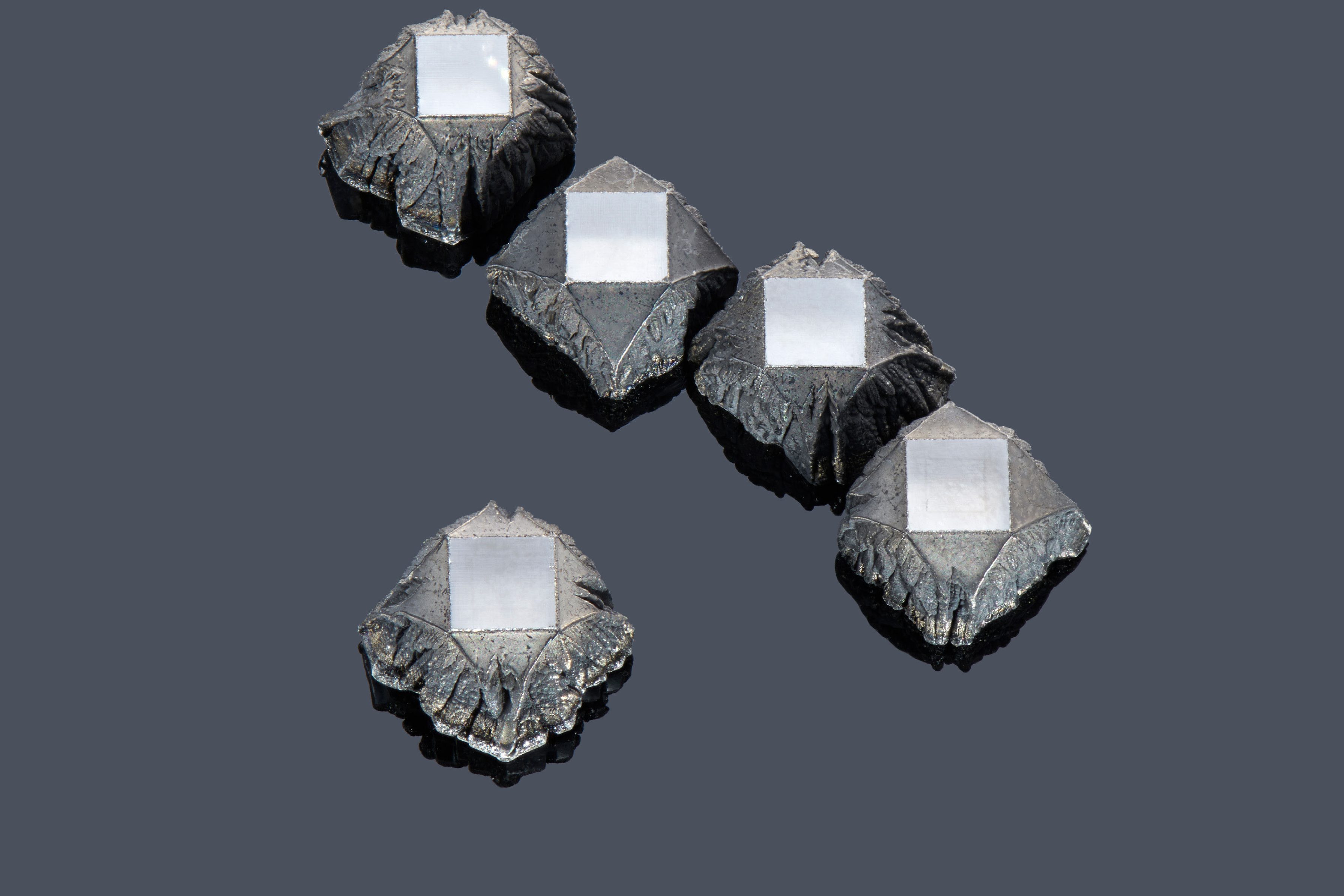
DIAMOND VERIFICATION
What are laboratory-grown diamonds?
Retailers can obtain specific grading reports or certifications from independent organisations that verify the quality of natural and synthetic diamonds.
While some grading laboratories will not certify laboratory-grown diamonds, others, such as the Gemological Institute of America (GIA), IGI and GSI, provide specifications and reports for laboratory-grown diamonds. These reports clearly state that the stone being graded is laboratory-grown and not natural.
GIA has recently announced that the Institute will no longer apply the 4Cs terminology for color and clarity as used to describe the characteristics of natural diamonds. This will ensure a clearer representation of the manufacturing specifications of laboratory-grown diamonds.
It is also important to beware of self-certified grading reports that are not independently verified and that may not clearly disclose the type of stone or that may make other claims on quality.
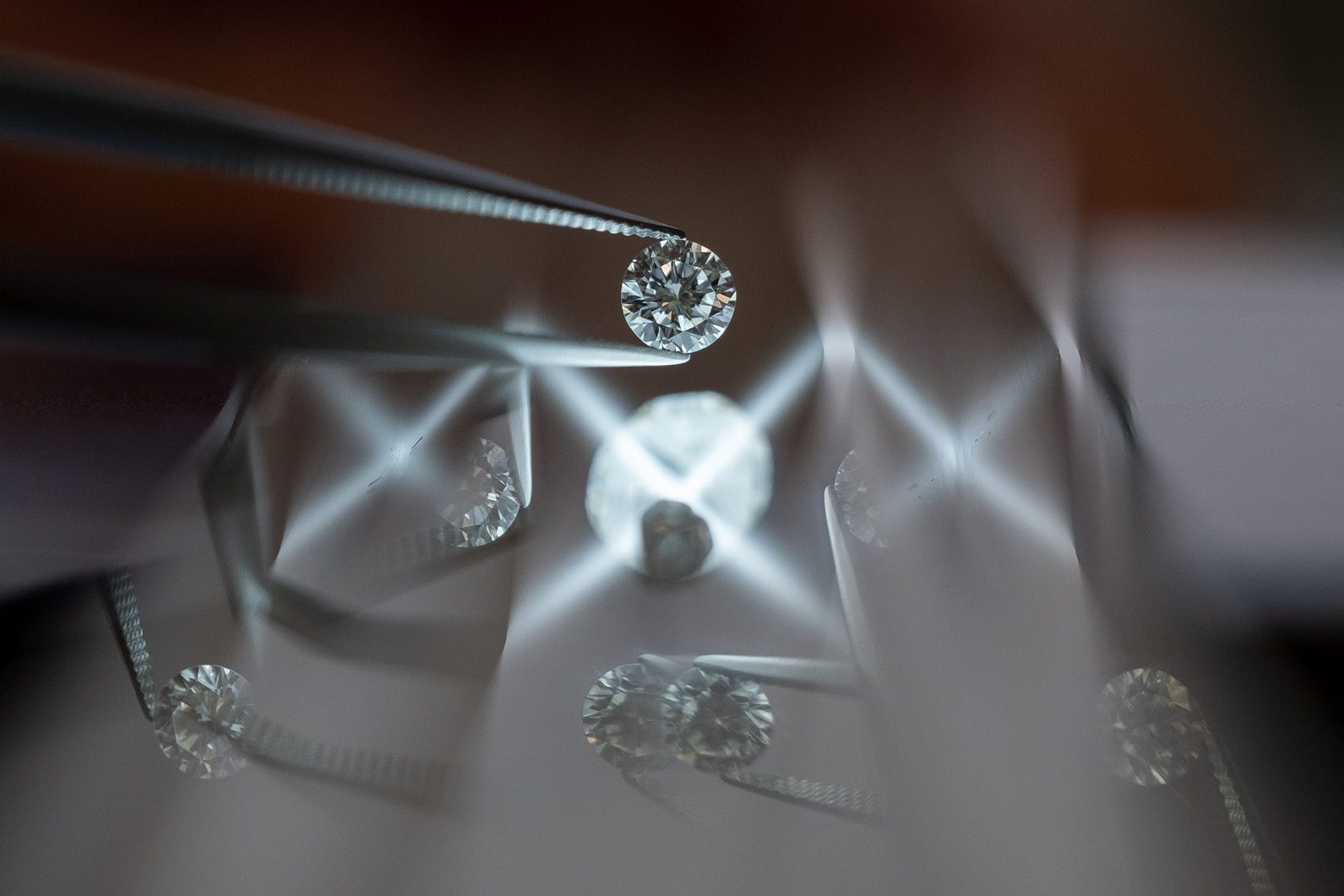
Are laboratory-grown and natural diamonds identical and indistinguishable?
No! Claims that laboratory-grown and natural diamonds are identical and impossible to tell apart are false.
Diamond crystals grow differently in nature from in a laboratory, meaning their grain patterns, just like those in wood, are different16. These structural differences may not always be visible to the naked eye but can always be detected using specialist verification instruments.
More than 20 instruments are available on the market to diamond industry professionals such as retailers, designers and manufacturers. By examining a wide range of indicators including spectral signature, composition, graining patterns and ultraviolet fluorescence reactions, they can detect whether a diamond originated billions of years ago in the Earth’s mantle or recently in a factory.
For example, production of colourless laboratory-grown diamonds requires the almost complete removal of nitrogen, a constituent of around 99% of natural diamonds17. Impurities in natural diamonds produced by their extended time under the Earth’s crust can also lead to very different responses to ultraviolet light.
The screening and detection instruments put all the clues together to reliably distinguish between natural and synthetic diamonds.
Diamond Verification Instruments are an integral part of the procedures that ensure pipeline integrity, preventing the mixing of synthetic diamonds and natural diamonds. In 2019, NDC established the ASSURE programme to assess the relative performance of diamond verification instruments on the market. Industry professionals can use the directory to guide them in choosing the instrument that will best serve their needs19.
With laboratory-grown diamonds appearing on the market in growing numbers, it is important to educate and challenge the misconception that they are indistinguishable from natural diamonds. Consumers should always understand the product they are buying, safe in the knowledge that they have received correct information about its origin.
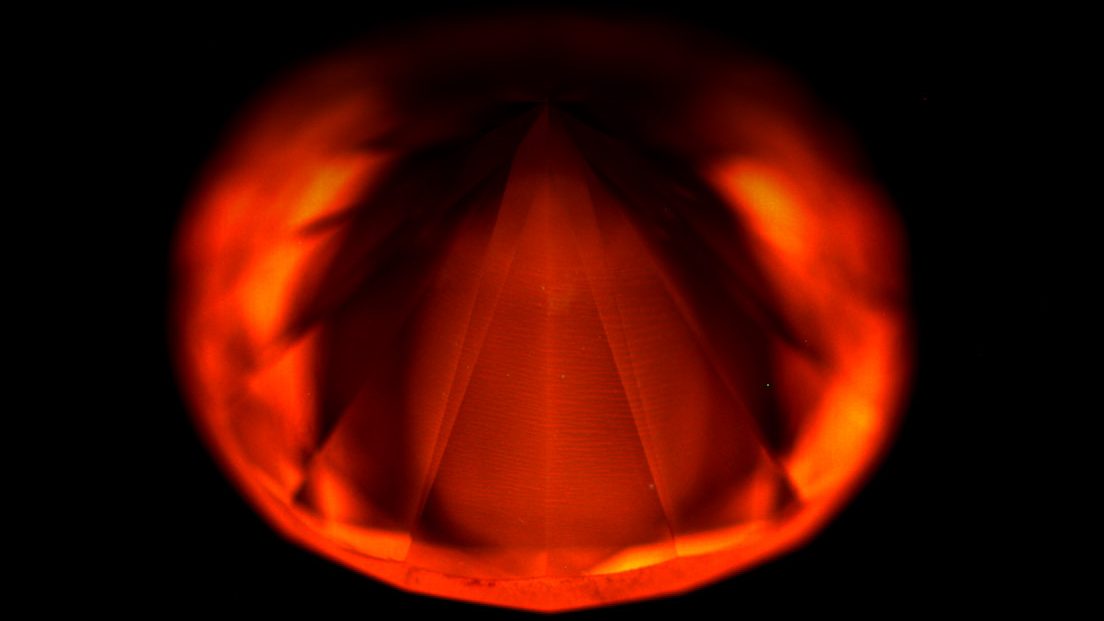
IMAGE CREDIT: De Beers Group, Science & Technology.
Laboratory-grown diamond (CVD), orange fluorescence with striations due to step flow growth.
SUSTAINABILITY CLAIMS
What are the sustainability claims?
The environmental footprint and sustainability commitments of the laboratory-grown diamond producers vary significantly depending on where and how the stone is created and how the producer manages energy, chemicals, materials, water and waste. It also depends on social factors such as human rights.

CARBON CLAIMS
Claims that all laboratory-grown diamonds have a low, neutral or even negative carbon footprint are not true. Whichever manufacturing method is used, the process lasts several days/weeks and is energy-intensive, requiring enormous pressure and temperatures above 2,000 degrees Fahrenheit. That’s equivalent to 20% of the temperature of the Sun’s surface20.
It is currently not feasible to heat laboratory-grown diamond reactors solely with renewable energy sources other than hydropower and, while some production facilities have managed to achieve this, it remains a limited option for most of the market. In fact, over 70% of laboratory-grown diamonds are mass-produced in China and India where 61% and 75% of grid electricity respectively is generated from coal21.
When retailers do make verifiable claims that their specific laboratory-grown diamonds are ‘carbon-neutral’ or ‘carbon-negative’, these usually rely heavily on carbon offsetting, meaning that emissions still occur during manufacturing. The claims tend also to cover only the creation of the unpolished product rather than its entire carbon footprint along the supply chain. Laboratory-grown diamonds are refined in carbon-intensive industrial environments.
CARBON CAPTURE
A number of laboratory-grown diamond producers and retailers make certain claims about carbon capture. Although some of these organisations highlight their use of carbon capture technology as an important way to mitigate environmental impacts of production, the actual volumes of CO2 contained in these diamonds is minuscule. The amount of carbon locked in a carat of laboratory-grown diamond (0.2 grams of carbon) is the equivalent of the carbon emitted when sending and receiving one to two emails22. By comparison, in one year a mature tree will absorb on average more than 48 pounds of CO2 from the atmosphere (and release oxygen in exchange!23).
This is the equivalent of carbon locked in close to 30,000 carats of laboratory-grown diamonds.
OTHER GREENWASHING RISKS
Beyond carbon neutrality claims, marketing campaigns about laboratory-grown diamonds sometimes mislead consumers by glossing over nuances regarding sustainable impact. For example:
• Some marketing campaigns state that laboratory-grown diamonds are mining-free. In fact, synthetic diamond processes can require graphite and metals. And the reactors in which laboratory-grown diamonds are created are built with metals that all originate from mining.
• Synthetic diamond producers use reactors with varying energy efficiencies, affecting the reliability of generalised figures.
• Large amounts of water are needed to cool reactors, posing a challenge for synthetic diamond-producing factories, many of which are in water-stressed regions.
SOCIAL IMPACT
Many sustainability claims about laboratory-grown diamonds overlook important social aspects, such as tax payments, employment and human rights, as well as the support provided for local communities. Laboratory-grown diamond manufacturing is capital-intensive with low headcount requirements. The natural diamond industry employs a far greater number of people. Claims that synthetic diamonds are more sustainable than natural diamonds often overlook the social benefits of natural diamond production – such as the support provided for local communities through employment, local procurement and the provision of infrastructure, social investments and health and educational partnerships. You can read about these in our reports (including examples from Botswana and Canada)24.
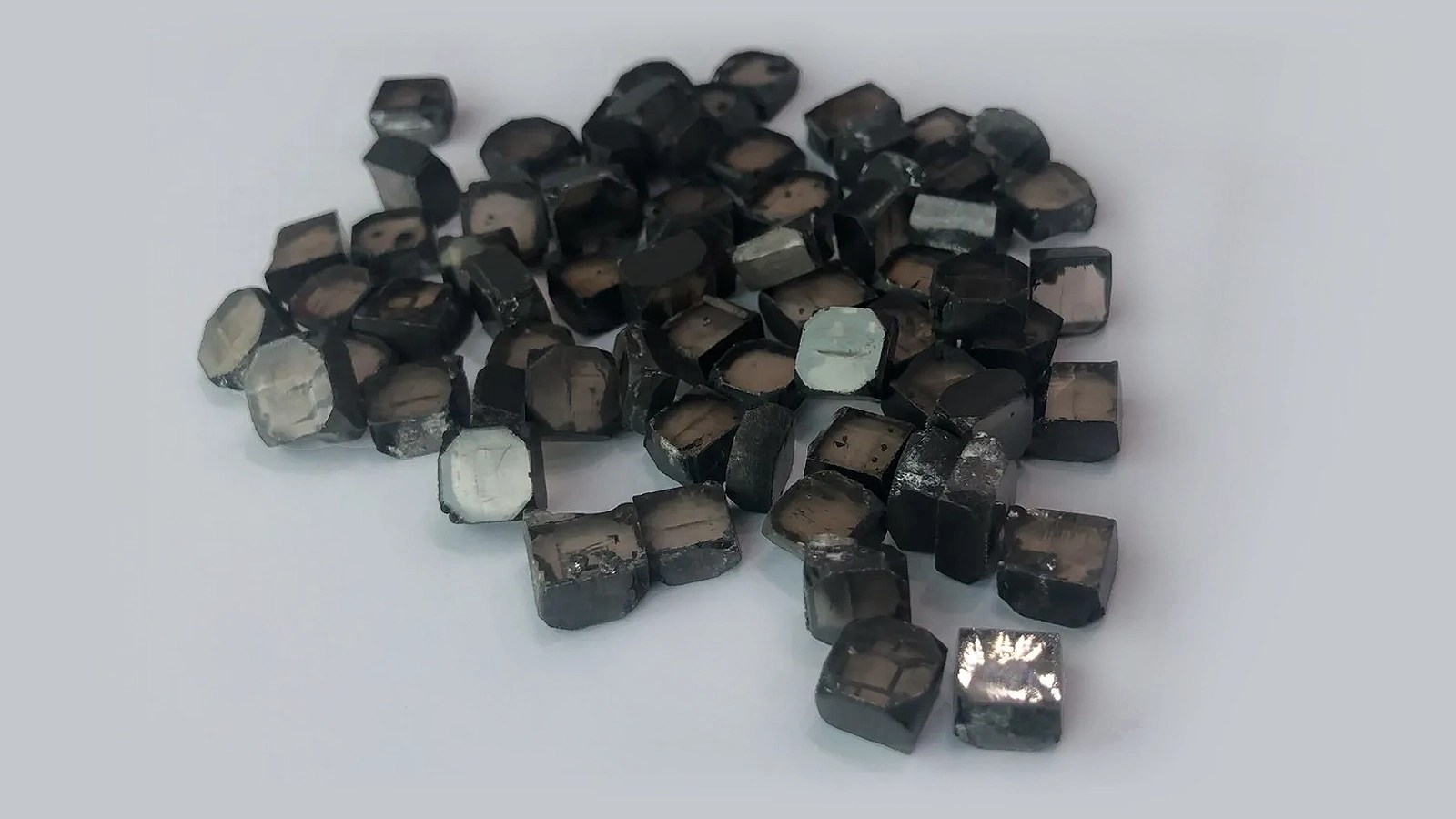
PRICE TRENDS and PRODUCTION COSTS
Why have laboratory-grown diamond prices fallen so much?
Prices of laboratory-grown diamonds have fallen significantly in recent years. For example, over the last ten years, the retail price of a 1.5 carat laboratory-grown stone has fallen 86% from $10,750 to $1,45525
The actual price of a synthetic diamond varies depending on its size and manufacturer. However, the key factors that influence the general lower price trend are falling production costs and the change in pricing structures.
PRODUCTION COST
When the first jewellery-quality synthesised diamonds appeared on the market in the 1970s, production costs were very high even though the stones were mostly small, and yellow or brown in colour.
Since the commercial development of CVD technology in the early 2000s, the cost of manufacturing has fallen dramatically in line with technological advances and economies of scale. Machines that were previously used to make industrial diamonds have also been repurposed for gems, bringing new producers to the market and ramping up competitive pressures.
Global management consultants Bain & Company estimate that in the 10 years from 2008 to 2018, the average production costs of a high-quality laboratory-grown 1-carat stone fell by 90%26.
RECENT PRICE TRENDS
A number of laboratory-grown diamond producers and retailers make certain claims about carbon capture. Although some of these organisations highlight their use of carbon capture technology as an important way to mitigate environmental impacts of production, the actual volumes of CO2 contained in these diamonds is minuscule. The amount of carbon locked in a carat of laboratory-grown diamond (0.2 grams of carbon) is the equivalent of the carbon emitted when sending and receiving one to two emails. By comparison, in one year a mature tree will absorb on average more than 48 pounds of CO2 from the atmosphere (and release oxygen in exchange!). This is the equivalent of carbon locked in close to 30,000 carats of laboratory-grown diamonds.
PRICING STRUCTURES
Since 2018, prices of laboratory-grown diamonds have continued to fall still further both at retail level and even more so at wholesale, demonstrating a big increase in retail margins on laboratory-grown diamonds over the period.
Consider, for example, a 1ct round near colourless (FGH) high-clarity (VS1) laboratory-grown diamond. Data supplied by analysts Edahn Golan27 on wholesale prices and Paul Zimnisky28 on retail prices shows that the wholesale price for this product is now just 5% of what it was 7 years ago in 2018 (i.e. it has fallen by 95%), while the retail price is 24% of what it was in 2018 (a fall of 76%).
Analysis by Paul Zimnisky for the last 5 years shows that the average retail margin on laboratory-grown diamonds has increased29 over the period from 46% to 84%. Put another way this means the average mark-up on synthetic diamonds has increased from 85% to over 500%30.
SOCIAL IMPACT
In nature, the available supply, size and quality mix of natural diamonds depends completely on geology. Large diamonds are very rare. It is not surprising therefore that a 2 carat stone can be priced significantly more than twice the price of a 1 carat stone as this is a reflection of its rarity.
This natural phenomenon does not exist in the synthetic diamond market, where the main constraint is the manufacturing capacity of each producer. A larger synthetic stone requires more energy and takes longer to produce than a smaller one, but the relationship is broadly linear – the production costs for a 2-carat stone are twice that of a 1-carat stone.
When laboratory-grown diamonds began appearing in commercial quantities in the jewellery market around 9–10 years ago, prices were typically slightly cheaper (around 10%) than those of natural diamonds of the same size. However, as the laboratory-grown diamond market has expanded and competitive pressures have increased, the relationship between natural diamond and laboratory-grown diamond prices has diverged. The differences have not been uniform across all sizes and qualities – they have been highest for larger stones because of the rarity of large natural diamonds.
AVERAGE PRICE FOR A 1 CT ROUND LABORATORY-GROWN DIAMOND 2018-2025 (VS1 CLARITY, FGH COLOUR)

SOURCES
https://cibjo.org/the-blue-books/*Gemological Institute of America. Available at: https://4cs.gia.edu/en-us/simulants-moissanite-and-lab-grown-diamonds/
1 Gemological Institute of America. Available at: https://www.gia.edu/synthetic-diamond-articles
2 GIA (2016) HPHT and CVD Diamond Growth Processes. Available at: http://gia.edu/hpht-and-cvd-diamond-growth-processes
3 GIA (2017) Observations on HPHT-grown synthetic diamonds. Available at: https://www.gia.edu/gems-gemology/fall-2017-observations-hpht-grown-synthetic-diamonds
4 GIA (2019) CVD Layer grown on natural diamond. Available at: https://www.gia.edu/gems-gemology/spring-2019-labnotes-cvd-layer-grown-on-natural-diamond
5 Kimberley Process Statistics (n.d.) Public statistics. Available at: https://kimberleyprocessstatistics.org/public_statistics
6,7 Bain & Company (2021): The Global Diamond Industry 2020-21. Available at: https://www.bain.com/globalassets/noindex/2021/bain_report_diamond_report-2020-21.pdf
8 IGI (2020) Some clarity on diamond clarity. Available at: https://www.igi.org/some-clarity-on-diamond-clarity/
9 GIA (2014) Tiny inclusions reveal diamond age and Earth’s history. Available at: https://www.gia.edu/gia-news-research-tiny-inclusions-reveal-diamond-age
10,11 IGI (2023) Inclusions seen in lab-grown diamonds. Available at: https://www.igi.org/inclusions-seen-in-lab-grown-diamonds/
12 12 ISO (n.d) ISO18323:2015 – Jewellery – Consumer confidence in the diamond industry. Available at: https://www.iso.org/standard/62163.html
13 CIBJO (n.d.) The blue books. Available at: https://cibjo.org/the-blue-books
14 JVC Legal (n.d.) Understanding the FTC Guidelines. Available at: https://jvclegal.org/understanding-the-ftc-guidelines/
15 Natural Diamond Council (n.d.) Diamond terminology. Available at: https://www.naturaldiamonds.com/industry-news/advertising-standards-authority-complaint-skydiamond-misleading-marketing-advertisement-
laboratory-grown-diamonds/
16 GIA (n.d.) Synthetic diamonds: Improved quality and identification challenges. Available at: https://www.gia.edu/gia-news-research-improved-quality-identification-challenges
17 GIA (2017) A synthetic diamond overgrowth on a natural diamond. Available at: https://www.gia.edu/gems-gemology/summer-2017-labnotes-synthetic-diamond-overgrowth-natural-diamond
18 GIA (2019) Diamonds from the deep: How old are diamonds? Are they forever? Available at: https://www.gia.edu/gems-gemology/spring-2019-how-old-are-diamonds-are-they-forever
19 Natural Diamond Council (n.d.) ASSURE Programme. Available at: https://www.naturaldiamonds.com/council/assure-diamond-verification/
20 NASA (n.d.) Temperature of the sun. Available at: https://science.nasa.gov/sun/facts/
21 Energy Institute Statistical Review of World Energy 2024. Available at: https://www.energyinst.org/__data/assets/pdf_file/0004/1055542/EI_Stat_Review_PDF_single_3.pdf
22 Report available upon request from Prizma Solutions. Available at: https://prizmasolutions.com/
23 US Department of Agriculture. Available at: https://www.usda.gov/media/blog/2015/03/17/power-one-tree-very-air-we-breathe
24 Diamond Reports series. Available at: https://www.naturaldiamonds.com/diamond-reports
25 Paul Zimnisky. Available at: https://www.paulzimnisky.com
26 Bain & Company: The Global Diamond Industry 2018. Available at: https://www.bain.com/contentassets/a53a9fa8bf5247a3b7bb0b10561510c2/
bain_diamond_report_2018.pdf
27 Edahn Golan. Available at: https://www.edahngolan.com/
28 Paul Zimnisky. Available at: https://www.paulzimnisky.com/
29 JCK. Available at: https://www.jckonline.com/editorial-article/lab-grown-narrative-is-changing/
30 Paul Zimnisky. Available at: http://www.paulzimnisky.com/Lab-grown-Diamond-Retail-Margin-Analysis-Chart





